Home
What's New
About Me
Rangefinders
Prismat
Fixed Lens
TL & DTL
XTL & X-1000
MSX & DSX
NC-1000
Z-Series
Other Mamiya
Related Links
Rest of
Collection
FAQ
Survey
Mamiya 35mm
Forum!

How To!


Donations
Help Fund
This Site!
Thanks for
Your Support!
|
A Brief Mamiya
History
Mamiya Camera Company, still a strong player in the medium-format
professional film and digital camera market, was founded May 10,1940 by
businessman Tsunejiro Sugawara (pronounced su-ga-WAR-a) and engineer Seichi
Mamiya (pronounced ma-MEE-yah), as Mamiya Koki Seisakusho.
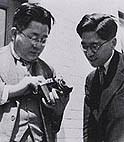
Tsunejiro Sugawara (left) and Seichi Mamiya
(right); c.May 1940
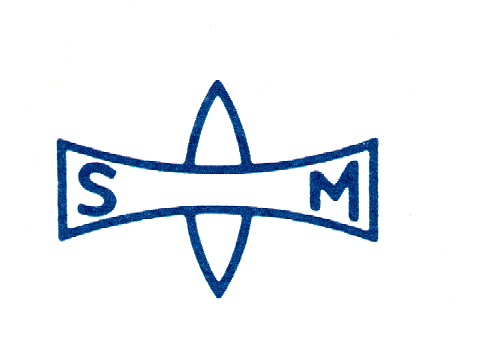
The stylized
symbol (above), seen on early Mamiya cameras, was designed in July 1940
by students of Japan Fine Arts School (the predecessor to the Japan Art
College), and stands for the initials of the two founders (and not Mamiya/Sekor,
as some have reported).
Their first product (which they can be seen holding in the picture above)
was the medium-format (120 film) folder Mamiya-6 (below). A fascinating
feature of this vintage folder is the way it focuses. The lens and bellows
do not move while focusing - the film plane does! Well made and highly successful,
it was the predecessor of Mamiya's first 35mm camera, the Mamiya 35-I, which
debuted in 1949.
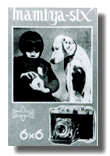 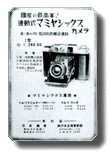
Two of the first advertisements that ran for
the new Mamiya-Six camera (c.1940)
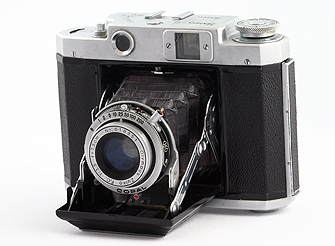
The Original Mamiya-6 Folding Camera (120
film), c. 1940
Mamiya Wartime History
The Mamiya facilities in Tokyo were destroyed during WWII,
and it was necessary to rebuild the entire company. In a strange decision
made by Allied Forces after the war, Japanese-made cameras could not be
sold to the Japanese public until the company's overseas volumes were
large enough for them to be considered a top camera exporter. There was
pent-up demand in their front yard that Mamiya could not tap!
Mamiya hoped to accelerate access to this demand by trying to establish
branch offices in New York and London. Mamiya was fortunate to receive
large orders from United States forces immediately following the war.
The first postwar production of Mamiya cameras were sold entirely to Allied
Forces personnel, not to the Japanese public, and a great many of the
original Mamiya-6 folders (like the example from my collection, above)
found their way to both the USA and UK.
Immediately following WWII, Mamiya faced many production problems. Shutters
and lenses were in short supply. Manufacturers began to make their own
to meet demand. Unable to buy a sufficient supply of shutters and lenses
from Chiyoda, their former supplier, Mamiya purchased a factory in Setagaya
(Tokyo) to manufacture shutters and lenses for themselves.
It was this Mamiya Setagaya factory (later called Setagaya Koki) that
originated the Sekor lens name. For a short time, Mamiya also bought lenses
from Olympus Optical.
Mamiya Cameras After the War

MAMIYAFLEX, (c.1948)
In 1948, Mamiya built Japan's first flash-synchronized twin lens reflex
(TLR) camera, the Mamiyaflex (seen above). Then, in 1949, building on
the success of the mid-size Mamiya-6 folder, they built their first 35mm
rangefinder model, the Mamiya 35-I (seen below).

MAMIYA 35-I, (c.1949)
The Mamiya 35-I was the first Japanese camera to automatically
cock a leaf shutter as the film was wound, and it had a fixed 5cm f/3.5
Hexar lens in a Copal B shutter, with speeds from 1 to 1/200. It adopted
the unique backfocusing arrangement of the Mamiya-6, in which the lens
did not move during focusing. However, problems developed in keeping the
film flat in a 35mm format, and the 35-I was eventually abandoned.
However, Mamiya was very aggressive in pursuing the "top exporter" goal. By 1950,
the company was incorporated as the Mamiya Camera Company, Ltd. By 1951, it
was listed on the Tokyo Stock Exchange and by May 1956, Mamiya was exhibiting
cameras at the prestigious Photokina international show.
|
Mamiya
Innovation
The following is a very brief chronology of Mamiya's 35mm camera development:

- 1949 Mamiya 35-I, the first 35mm Mamiya camera.
- 1956 Mamiya 35-III, the first Mamiya helical focus rangefinder
with self-cocking lever and linked finder.
- 1957 Mamiya Magazine 35, the first production 35mm camera with
an interchangeable film back.
- 1958 Mamiya Elca, the first Japanese camera with match-needle
metering.

- 1959 Mamiya Ruby, which would become the style basis for several
Mamiya rangefinders.
- 1961 Mamiya Prismat, Mamiya's first 35mm SLR.

- 1961 Mamiya Prismat PH, Mamiya's first leaf shutter SLR.
- 1964 Mamiya Prismat CWP (in USA - CP elsewhere) used a 42mm
threaded lens mount.
- 1966 Mamiya 500TL, Mamiya's first 35mm with CdS through the
lens (TTL) metering.

- 1968 Mamiya 500DTL, the first 35mm SLR with dual spot/averaging
CdS TTL metering.

- 1971 Mamiya AutoXTL, arguably the most advanced 35mm SLR of
its time.

- 1978 Mamiya NC1000, a quality lightweight 35mm SLR system,
with a full complement of lenses.

- 1980 Mamiya ZE, the first Japanese SLR to use an electronic
coupling system to transmit information between the camera body and
its interchangeable lenses.
Untimely Financial Changes
In 1984, plans for the expansion of Mamiya's popular Z-series of
35mm cameras were halted when Mamiya's main international distributor,
Osawa (formerly Bell & Howell Japan) declared
bankruptcy. It was the largest financial failure in modern Japanese history,
and caused significant disruption to Mamiya product distribution, creating severe
financial difficulties.
Camera production continued at Mamiya factories only with the support
of the Japanese government and the Cosmo 80 Group, one of Japan's leading
computer programming companies. Mamiya continuted to manufacture
their profitable medium-format SLRs (the fabulous Mamiya 645 Super
was released to the market in 1985), but by June 1984 all Mamiya 35mm
camera production had ceased.

In February, 1988, Mamiya completed its reorganization. However, those
years of financial woe forever ended Mamiya's 35mm camera production.
Osawa itself eventually recovered, but not before Mamiya had already
shifted its entire marketing priority to the medium-format professional market.
 
Soon after reorganization, the highly acclaimed Mamiya-6
and Mamiya-7 medium-format SLR cameras were introduced.
The End of An Era
Tsunejiro Sugawara died in April 1988, shortly after Mamiya's successful
financial reorganization. In January 1989, Seichi Mamiya, the engineer who
designed their first camera, co-founded the company and gave it its name,
also passed away.
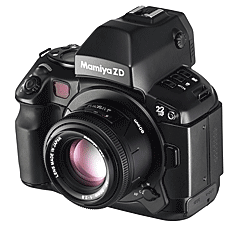
Mamiya and the Digital Revolution
In 2005, Mamiya Corporation announced one of the world's most advanced
medium-format professional cameras, the 22-megapixel Mamiya ZD.
On September 1, 2006, Mamiya Optical transferred all assets to Cosmo Digital
and formed a new company, Mamiya Digital Imaging. The Mamiya nameplate
will continue, and service will also be available in the existing Mamiya network.
In November 2006, Mamiya Digital Imaging introduced two new medium-format lenses:
an f/4.5 autofocus 75-150mm compact zoom and the world’s first medium-format,
super wide-angle, an aspherical 28mm f/4.5.
Digital Photo Review: 22mp Mamiya ZD preview
PDN Online Review: "...most interesting digital
ever..."
Luminous Landscape: review of the Mamiya ZD.
Mamiya ZD Review: now on sale in Europe!
|




